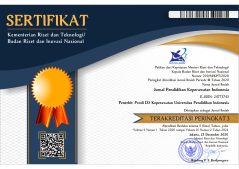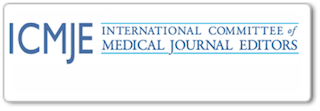Gender Issues on the Geography of Emotions About Covid-19 in Adolescents
Abstract
Introduction: The COVID-19 pandemic emerged abruptly and is characterized by its high transmissibility, resulting in heightened levels of anxiety and depression within the community. Indonesia represents one of the nations significantly impacted by the COVID-19 pandemic. Since the onset of the virus, children and adolescents have experienced increased feelings of anxiety and stress. Emotional disorders can be precipitated in children and adolescents exhibiting symptoms of anxiety, fear, stress, restlessness, or worry. Objective: The objective of this study was to explore gender-related issues in the emotional landscape of COVID-19 among junior high school students. Method: The research employs a quantitative approach. Data collection was executed through a Google Form containing a series of statements. The instrument utilized for data gathering was the 2020 COVID Stress Scales (CSS), which comprises 36 statement items. The population under investigation consisted of 1,640 students, from which a sample of 328 junior high school students was selected based on predefined inclusion and exclusion criteria. Results: The findings indicated that the emotional geography of students exhibited the highest mean score in the Xenophobia domain, with an average value of 3.394, while the lowest mean score was observed in the Compulsive Checking Emotional Geography, with an average value of 2.107; moreover, a statistically significant difference in mean values was noted. Emotional geography, particularly within the socio-economic domain, displayed differences between boys and girls, with a p-value of 0.000. Conclusion: Distinct emotional differences between boys and girls were identified in relation to contamination, xenophobia, and socio-economic ramifications. It is imperative for schools and parents to provide psychological support, facilitate the dissemination of information, and offer behavioral guidance at both individual and community levels.
Keywords
Full Text:
PDFReferences
ALMI (Indonesian Young Scientist Academy). (2020). What’s the Difference between Pandemic, Epidemic and Outbreak [Internet]. Available from: https://almi.or.id/2020/03/12/apa-bedanya-pandemi-epidemi-dan-wabah/
Asmundson GJG, Taylor S. (2020). How health anxiety influences responses to viral outbreaks like COVID-19: What all decision-makers, health authorities, and health care professionals need to know. J Anxiety Disord. 71:102211.
Cheng SKW, Wong CW, Tsang J, Wong KC. (2004). Psychological distress and negative appraisals in survivors of severe acute respiratory syndrome (SARS). Psychol Med. 34(7):118-795.
GTPP (Gugus Tugas Percepatan Penangan) COVID-19. (2020). Data Sebaran Global dan Nasional. Artikel Informasi. https://covid19.go.id/
Hockenberry M. J, Wilson D. (2018). Wong’s nursing care of infants and children-E-book. Elsevier Health Sciences.
Ningsih E. Saam Z. Umari T. (2021). Studi Literatur Tentang Konsep Diri Remaja. Jurnal Online Mahasiswa (JOM) Bidang Keguruan dan Ilmu Pendidikan. 8(1), 55–63.
Nordmeyer, N, V. Lemaire, P. (2025). How do positive and negative emotions influence children’s and adolescents’ arithmetic performance?. PLoS ONE 20(4): e0309573. https://doi.org/ 10.1371/journal.pone.0309573.
NSPCC Learning. Corona virus briefing: guidance for social workers. https://learning. nspcc.org.uk/media/2196/coronavirus-briefing-guidance-for.social-workers.pdf.
NSPCC Learning. What children are saying to child line about corona virus. https://learning. nspcc.org.uk/media/2195/what-children-are-saying-tochildline-about-coronavirus.pdf.2020.
Perasso, G., Serantoni, G., Lillo, C., Maculan, A., Paoletti, P., & Di Giuseppe, T. (2024). Emotions, social support and positive resources during Covid-19 pandemic: A qualitative-quantitative survey among italian adolescents. RICERCHE DI PSICOLOGIA. https://doi.org/10.3280/rip2023oa16630.
Rubin GJ, Amlôt R, Page L, Wessely S. (2009). Public perceptions, anxiety, and behaviour change in relation to the swine flu outbreak: cross sectional telephone survey. Bmj. 339.
Sainju et al., 2022, Xenophobic Bullying and COVID-19: An Exploration Using Big Data and Qualitative Analysis, Int. J. Environ. Res. Public Health 2022, 19, 4824. https://doi.org/ 10.3390/ijerph19084824.
Siemaszko C. Coronavirus Outbreaks labeled pandemi WHO. https://www.nbcnews.com/health/ healthnews/coronavirusoutbreaklabeledpandemi-world-health-organization-n1155741. 2020.
Taylor S, Landry CA, Paluszek MM, Groenewoud R, Rachor GS, Asmundson GJG. (2020). A proactive approach for managing COVID-19: the importance of understanding the motivational roots of vaccination hesitancy for SARS-CoV2. Front Psychol. 11:575950.
Taylor S, Quinn F, Jenkins K, Miller-Brown H, Rizk N, Prodromou T. Taylor S.(2019). The psychology of pandemics: Preparing for the next global outbreak of infectious disease Newcastle upon Tyne. UK: Cambridge Scholars Publishing. 98–103.
Tiwari S. (2020). Q-Bot, the Quarantine Robot: Joint-media engagement between children and adults about quarantine living experiences. Information and Learning Sciences. 121(5/6): 401–9.
Wang Y, Di Y, Ye J, Wei W. (2021). Study on the public psychological states and its related factors during the outbreak of coronavirus disease 2019 (COVID-19) in some regions of China. Psychol Health Med. 26(1):13–22.
WHO. (2020). Coronavirus: symptoms World Health Organization. Disponível. 7. https://www. whoint/healthtopics/coronavirus#tab=tab_3Acesso.
DOI: https://doi.org/10.17509/jpki.v11i1.85535
Refbacks
- There are currently no refbacks.
Jurnal Pendidikan Keperawatan Indonesia(JPKI) published by Indonesia University of Education. JPKI is licensed under a Creative Commons Attribution-ShareAlike 4.0 International License.
Office :
Nursing Department. FPOK UPI.
229, Dr. Setiabudhi Street. Bandung 40154
West Java , Indonesia
E-mail : jpki@upi.edu

_.png)
_.png)
_.png)











